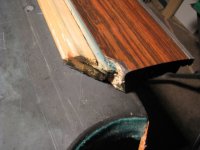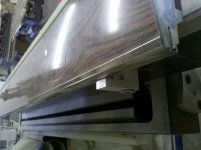Rob, I'm not talking about one dimensional as in line of sight buddy, I'm talking about you basing everything about rebuilding rails on your milling machine. The total accuracy in the ability to rebuild the sub-rails are based on two very important factors, (1) the feather strip dado, and (2) the height of the rail above the level of the slate and parallel relationship of the rail to the flatness of the slate.
(1) Sub-rails vary in width.
(2) Sub-rails vary in thickness.
(3) Rails vary in width, such as the Formica on GC rails are anywhere from 4 1/8"th to 4 3/16"th wide.
(4) The outside trim molding on GC's are not always parallel to the sub-rail.
(5) The rails are not always flat, or straight.
(6) If the rails are stapled out, your mill is pretty much worthless to fix that problem, since when the rails are being dadoed out, you still need to be able to use the feather strip as the guide line in order to create a straight and parallel cloth relief in a straight relationship to the feather strip dado.
I could go on, but what's the point, your "Ultimate" tooling can't get past the flaws I just posted.
Question for you Rob, if you have to re-cut the feather strip dado 5/16" wide and 3/8" deep but the rail is bowed out in the center....can you re-cut it with your mill...without removing any of the Formica finish, or going wider than 5/16" dado?
I grew up on a hog farm, the hogs got slaughtered first so that the other pigs would get their share of the feed...and we raised over 500 pigs at one time....so there is a meaning in that saying

Ok, we aren't on the same page... no problem.
1) Subrail width, yes I have many bolting locations. If I need a new pattern, I drill it on the mill. I can easily indicate any point of the rail in within 0.0005", just try finding a straight place at anywhere near that accuracy.
2)Subrail thickness, Since I am not going to scribed lines on a piece of plywood this is not an issue. The mill head rotate 180degrees on 2 axis, extends and withdraws a total of 18" of travel. The quill has 6" of z-axis travel. The bed is 50x14" and I have the fixture plate made in a way it rides in the T-slots to take longer passes.
3/4) Formica? None of this affects crap, and I work on more than 2 tables. My fixture works for all (yes, even medalist 1 piece).
5)Rails are not always flat or straight? You must be kidding. They are "never" flat or straight. Why do you think I bolt them down to the fixture as if they were on the slate. And before you say the slate is better, the fixture is flat and paralell to 0.004 over 62". You will probably never see a slate that accurate.
6)Stapled out rails? This is funny actually. I can mount the rails upright (subrail pointed up) should I ever need to (just need 3 holes...) Then I can mill the dado flat and true to add wood to if it needs it. Again, precisely.
I don't bash you for not having manufacturing knowledge, you are a terrific shade-tree designer. Using your creativity you do some awesome work. My point is that I actually went to school for the accurate manufacturing that I speak of. The material does not matter, it is the process and having the tool for the job.
Recut the featherstrip dado... Do you mean, cut the dado deeper while following the current profile, even if it was bowed? To that, I would have to modify a plate to follow the profile and then use either a router or a circular saw. If on the other hand you wanted to recut the dado straight, then replace the top of the subrail to maintain the 5/16? width, that is easy as well. You are grabbing at air. No hand process has the accuracy of a 4000# machine. Just plain and simple.
Just wait until more mechanics see the machine in use. The only rational argument against it is the cost, lack of portability and time.
Rob

